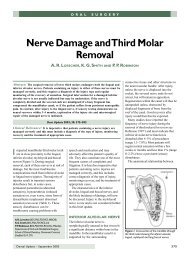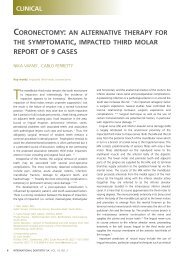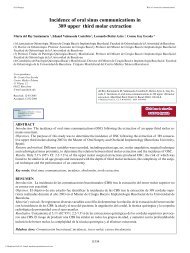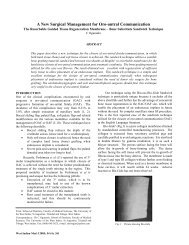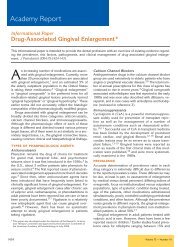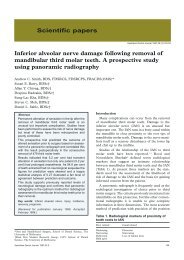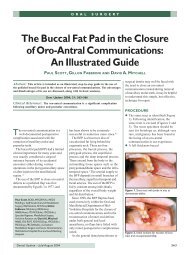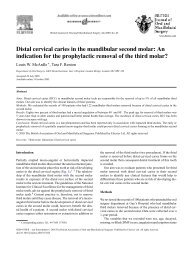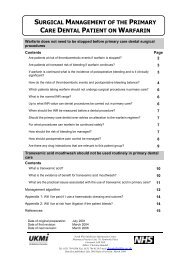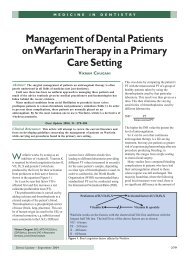Treatment of Oroantral Fistula Vanja Vuksan ... - Exodonti.info
Treatment of Oroantral Fistula Vanja Vuksan ... - Exodonti.info
Treatment of Oroantral Fistula Vanja Vuksan ... - Exodonti.info
Create successful ePaper yourself
Turn your PDF publications into a flip-book with our unique Google optimized e-Paper software.
<strong>Treatment</strong> <strong>of</strong> <strong>Oroantral</strong> <strong>Fistula</strong><br />
Klara Sokler 1<br />
<strong>Vanja</strong> <strong>Vuksan</strong> 2<br />
Tomislav Lauc 3<br />
1 Clinical Department <strong>of</strong> Oral<br />
Surgery<br />
Clinical Hospital “Dubrava”,<br />
Zagreb<br />
2 Policlinic <strong>of</strong> Dental<br />
Medicine, Zagreb<br />
3 Institute <strong>of</strong> Anthropology,<br />
Zagreb<br />
Summary<br />
The authors present the problems <strong>of</strong> oroantral fistula by reviewing<br />
the possibilities <strong>of</strong> surgical treatment. Known and less known operative<br />
methods are described and their advantages and disadvantages analysed.<br />
The object <strong>of</strong> this study is to remind the reader <strong>of</strong> the iatrogenic possibility<br />
<strong>of</strong> the occurrence <strong>of</strong> an antrooral communication and possibility<br />
<strong>of</strong> the development <strong>of</strong> a fistula and infection <strong>of</strong> the maxillary sinus, and<br />
to warn against unnecessary use <strong>of</strong> extreme surgical methods, which<br />
were once performed routinely. The result <strong>of</strong> treatment <strong>of</strong> antrooral<br />
communication should be the establishment <strong>of</strong> physiological functions<br />
<strong>of</strong> the stomatognathic and respiratory system with as little harm to the<br />
patient as possible.<br />
Key words: oroantral fistula, vestibular flap, palatinal flap.<br />
Acta Stomat Croat<br />
2002; 135-140<br />
REVIEW<br />
Received: January 16, 2002<br />
Address for correspondence:<br />
Klara Sokler<br />
Clinical Department <strong>of</strong> Oral<br />
Surgery<br />
Clinical Hospital “Dubrava”<br />
Avenija G. ©uπka 6<br />
10040 Zagreb<br />
Croatia<br />
Introduction<br />
The term oroantral fistula is understood to mean<br />
a fistular canal covered with epithelia which may or<br />
may not be filled with granulation tissue or polyposis<br />
<strong>of</strong> the sinal mucous membrane, and which most<br />
frequently occurs because <strong>of</strong> iatrogenic oroantral communication.<br />
In such cases communication between<br />
the oral cavity and the maxillary sinus occurs as a<br />
result <strong>of</strong> extraction <strong>of</strong> upper lateral teeth, which do<br />
not heal by means <strong>of</strong> a blood clot but inside which<br />
granulation tissue forms, and on the edges narrowing<br />
<strong>of</strong> its vestibule occurs by migration <strong>of</strong> the epithelia<br />
cells <strong>of</strong> the gingival proprie, which cover the edges<br />
<strong>of</strong> the vestibule and partially grow into the canal.<br />
During expiry the air current which passes from the<br />
sinus through the alveoli into the oral cavity facilitates<br />
the formation <strong>of</strong> a fistular canal, which connects<br />
the sinus with the oral cavity. The fistula may<br />
spontaneously close by swelling <strong>of</strong> the gingiva,<br />
although the chances <strong>of</strong> this occurring are not great.<br />
With the presence <strong>of</strong> a fistula the sinus is permanently<br />
open, which enables the passage <strong>of</strong> micr<strong>of</strong>lora<br />
from the oral cavity into the maxillary sinus and<br />
the occurrence <strong>of</strong> inflammation with all possible<br />
consequences.<br />
Because <strong>of</strong> the anatomic position <strong>of</strong> the maxillary<br />
sinus and its connection with the teeth it is particularly<br />
important in the field <strong>of</strong> oral and maxill<strong>of</strong>acial<br />
surgery.<br />
The largest part <strong>of</strong> the upper jaw is taken up by<br />
the maxillary sinus, which is described as a large,<br />
pneumatic space. It is also known as Highmore’s<br />
Acta Stomatol Croat, Vol. 36, br. 1, 2002. ASC<br />
135
Klara Sokler et al.<br />
<strong>Treatment</strong> <strong>of</strong> <strong>Oroantral</strong> <strong>Fistula</strong><br />
Antrum after the English anatomist Nathaniel Highmore<br />
from the 17th century, who first described the<br />
sinus as a space in the bone and called it the antrum<br />
(1).<br />
At birth the maxillary sinus is present as a small<br />
cavity, as its growth begins in the third month <strong>of</strong><br />
foetal life, and ends between the 18th and 20th year<br />
<strong>of</strong> life. The volume <strong>of</strong> the maxillary sinus is the<br />
result <strong>of</strong> functional development <strong>of</strong> the maxilla and<br />
its pneumatisation, and it therefore increases at the<br />
same rate as the growth <strong>of</strong> the jaws and eruption <strong>of</strong><br />
permanent teeth. Because <strong>of</strong> the smaller volume <strong>of</strong><br />
the sinus the risk <strong>of</strong> the occurrence <strong>of</strong> oroantral communication<br />
in children and adolescents is less. In<br />
adults the volume <strong>of</strong> the sinus amounts to 20-25 ml<br />
(2, 3).<br />
A clinical study by Guven in 1998 indicated that<br />
oroantral fistula most frequently occurs after the<br />
third decade <strong>of</strong> life (4), which agrees with the results<br />
<strong>of</strong> other authors such as Lin in 1991 (5) and Punwutikorn<br />
and co-workers in 1994. Investigations<br />
have also shown that the relation <strong>of</strong> pneumatisation<br />
<strong>of</strong> the jaw in men and women is identical (6-8),<br />
although in 1991 Lin et al. in 1991 reported that the<br />
maxillary sinus is more developed in women and<br />
that there is therefore greater possibility <strong>of</strong> the<br />
occurrence <strong>of</strong> oroantral communication and fistula<br />
in women (5). Guven concluded that the occurrence<br />
<strong>of</strong> chronic sinusitis and antral polyp is frequently a<br />
consequence <strong>of</strong> oroantral fistula. If during tooth<br />
extraction the sinus is open, but no inflammation is<br />
present, its spontaneous closure frequently occurs.<br />
When a clinical diagnosis <strong>of</strong> chronic sinusitis is<br />
made radiographic follow-up <strong>of</strong> the sinal inflammation<br />
is necessary (4).<br />
The floor <strong>of</strong> the sinus is <strong>of</strong>ten uneven and deepened,<br />
which can be determined by determining the<br />
position <strong>of</strong> the lowest part <strong>of</strong> the sinus to the floor<br />
<strong>of</strong> the nasal cavity. The floor <strong>of</strong> the sinus can have<br />
three basic positions: beneath the level <strong>of</strong> the floor<br />
<strong>of</strong> the nasal cavity, on its level or above its level.<br />
The relation is particularly important, in which the<br />
floor <strong>of</strong> the maxillary sinus is beneath the level <strong>of</strong><br />
the floor <strong>of</strong> the nasal cavity, because its floor can<br />
extend to the tops <strong>of</strong> the dental roots, or go even<br />
deeper between them. Such roots are separated from<br />
the sinus by a thin bony lamela and its mucous<br />
membrane, or very rarely only by the mucous membrane<br />
<strong>of</strong> the sinus. The thickness <strong>of</strong> the bone wall<br />
varies and is on average 0.2 - 16 mm (3, 9).<br />
The symptoms which occur during the occurrence<br />
<strong>of</strong> an oroantral fistula are similar to the<br />
symptoms <strong>of</strong> oroantral communication. A purulent<br />
discharge may drip through the fistula, which cannot<br />
always be seen. Also, when the patient drinks he<br />
feels as though part <strong>of</strong> the liquid enters the nose<br />
from that side <strong>of</strong> the jaw and occasionally runs out<br />
<strong>of</strong> the nostril on the same side. When the nostrils are<br />
closed with the fingers and the patient is asked to<br />
blow through the nose, air hisses from the fistula<br />
into the mouth. A similar occurrence happens when<br />
the patient blows out his cheeks, only then the air<br />
passes from the mouth into the sinal and nasal cavity,<br />
the so-called Valsalvin test (3). In some cases<br />
the test <strong>of</strong> blowing through the nose or mouth does<br />
not necessarily give a positive answer, e.g. when the<br />
fistular canal is filled with inflammatorily changed<br />
sinal mucous membrane. However, the test with a<br />
blunt probe will confirm the existence <strong>of</strong> a fistular<br />
canal (10).<br />
Therapy consists <strong>of</strong> the following. The fistula<br />
must be quickly closed as its persistence intensifies<br />
the possibility <strong>of</strong> inflammation <strong>of</strong> the sinus by<br />
infection from the oral cavity. It is important to<br />
establish whether or not infection <strong>of</strong> the sinus has<br />
occurred during the existence <strong>of</strong> the fistula. The<br />
presumption is that the duration and width <strong>of</strong> the<br />
lumen <strong>of</strong> the fistular canal contributes to infection<br />
<strong>of</strong> the sinus, although infection <strong>of</strong> the sinus is possible<br />
in a short period and with a very narrow<br />
fistular canal (3).<br />
Some authors, such as Hanazawe, report that an<br />
oroantral fistula <strong>of</strong> less than 2 mm diameter has the<br />
possibility <strong>of</strong> spontaneous healing, while in the case<br />
<strong>of</strong> a diameter <strong>of</strong> more than 3 mm spontaneous healing<br />
is hampered because <strong>of</strong> the possibility <strong>of</strong> inflammation<br />
<strong>of</strong> the sinus or periodontal region (11).<br />
In 1957 Martensson, in contrast to Hanazawe,<br />
considered that there is less possibility <strong>of</strong> spontaneous<br />
healing when the oroantral fistula has been<br />
present for 3 to 4 weeks, or when its diameter is<br />
greater than 5 mm (12).<br />
In his investigation in 1982 Von Wovern demonstrated<br />
that the oroantral fistula did not heal well in<br />
21% <strong>of</strong> cases, when no preoperative treatment <strong>of</strong><br />
136<br />
ASC Acta Stomatol Croat, Vol. 36, br. 1, 2002.
Klara Sokler et al.<br />
the sinal infection was performed, compared to only<br />
2% <strong>of</strong> cases which did not heal with controlled<br />
infection <strong>of</strong> the sinus (13).<br />
In 1973 Amπel wrote <strong>of</strong> the possibility <strong>of</strong> protection<br />
by a flap for closing the antrooral communication<br />
with a palatinal plate. In 1977 he described<br />
probably the simplest method <strong>of</strong> treatment <strong>of</strong> fresh<br />
antrooral communication, also with a palatinal plate.<br />
By this method, immediately after tooth extraction<br />
and the occurrence <strong>of</strong> communication, airflow through<br />
the alveoli into the sinus is prevented and its<br />
spontaneous healing enabled, i.e. prevention <strong>of</strong> the<br />
occurrence <strong>of</strong> a fistula. With simultaneous antibiotic<br />
protection the method is very successful and is<br />
routinely applied in practice in this country (14, 15).<br />
In 1985 KrmpotiÊ and Bagatin described immediate<br />
closure <strong>of</strong> an antrooral communication with a<br />
rotating gingivovestibular flap. The method can also<br />
be applied for closure <strong>of</strong> an antrooral fistula, and<br />
consists <strong>of</strong> a modification <strong>of</strong> a vestibular flap with<br />
the aim <strong>of</strong> avoiding the lowering <strong>of</strong> the fornix,<br />
which regularly accompanies the application <strong>of</strong><br />
vestibular flaps (20).<br />
A review <strong>of</strong> operative techniques<br />
Numerous surgical methods have been described<br />
for treatment <strong>of</strong> oroantral fistulas, although only a<br />
few have been accepted in daily practice (16).<br />
In 1936 Rehrmann first published a method for<br />
closing an oroantral fistula by a simple and efficient<br />
method, the method <strong>of</strong> a buccal flap (17).<br />
The method <strong>of</strong> a buccal flap starts with an incision<br />
around the opening <strong>of</strong> the communication, at a distance<br />
<strong>of</strong> 3 to 4 mm, as the opening <strong>of</strong> the s<strong>of</strong>t tissue<br />
is always smaller than the opening <strong>of</strong> the sinus itself.<br />
The communication can be closed with one layer,<br />
if the tissue around the opening is cut and removed,<br />
and the vestibular flap is the only layer, or it can be<br />
closed with two layers, if after partial elliptic incision<br />
the s<strong>of</strong>t tissue from the vestibular and palatinal<br />
side is turned and carried over the fistular opening<br />
and resorptive sutures made above it, and thus the<br />
internal layer is obtained and the outer layer consists<br />
<strong>of</strong> a vestibular flap, which completely covers it. In<br />
order to obtain a vestibular flap two vertical incisions<br />
are made; from each side towards the buccal<br />
<strong>Treatment</strong> <strong>of</strong> <strong>Oroantral</strong> <strong>Fistula</strong><br />
sulcus. The base <strong>of</strong> the flap is always wider to<br />
enable a better supply <strong>of</strong> blood to the flap. If the flap<br />
cannot be brought over the opening <strong>of</strong> the communication,<br />
a horizontal counter incision is made in<br />
the base through the perisosteum (17). The advantage<br />
<strong>of</strong> the buccal flap method is that it can be used<br />
in cases when the alveolar ridge is very low and<br />
when it is impossible to apply the method <strong>of</strong><br />
inerseptal alveotomy (18). In 1975 Killey and Kay<br />
reported success with this method in 93% <strong>of</strong> cases<br />
(16)<br />
A disadvantage <strong>of</strong> the method is that it does not<br />
protect the bone base (18), and in 1981 ObradoviÊ<br />
et al. concluded that with the buccal flap significant<br />
lowering <strong>of</strong> the vestibulum and cheek oedema occur<br />
(19), while in 1982 Von Wovern recommended the<br />
use <strong>of</strong> buccal flap for edentulous jaws only (13).<br />
In 1939 Ashley was first to describe a method <strong>of</strong><br />
using a palatinal flap <strong>of</strong> full thickness in order to<br />
close an oroantral fistula. The method <strong>of</strong> palatinal<br />
flap enabled the closure <strong>of</strong> a fistular opening with<br />
the mucous membrane <strong>of</strong> the hard palate (21).<br />
A medial incision is slightly more lateral than the<br />
medial line <strong>of</strong> the palate, and a lateral incision<br />
follows the edge <strong>of</strong> the gingiva or is about half a<br />
centimetre along the edge <strong>of</strong> the gingiva <strong>of</strong> the tooth<br />
on that side <strong>of</strong> the jaw. A convex incision is made<br />
towards the front, which joins the medial and lateral<br />
incisions. The flap is bent to a right angle and its<br />
front edge is sutured with the edge <strong>of</strong> the vestibular<br />
mucous membrane (21).<br />
A palatinal flap contains blood vessels, which<br />
enable a satisfactory blood supply, and with its thickness<br />
and width it covers the site <strong>of</strong> the fistula better<br />
and safer (21). In 1980 Ehrl concluded that this<br />
method could also be applied for oroantral fistulas<br />
larger than 1 cm diameter (22). An advantage <strong>of</strong> this<br />
method compared to the method in which a buccal<br />
flap is used, is that no lowering <strong>of</strong> the vestibulum<br />
occurs and the flap is firmer and more resistant to<br />
trauma and infection than the buccal flap (22). A<br />
disadvantage <strong>of</strong> this method may be considered the<br />
denudation <strong>of</strong> the palatal surface, pain, and the later<br />
appearance <strong>of</strong> roughness and deepening <strong>of</strong> this area<br />
as a result <strong>of</strong> secondary epithialization over two to<br />
three months. The most unpleasant possible complication<br />
is necrosis <strong>of</strong> the palatinal flap.<br />
Acta Stomatol Croat, Vol. 36, br. 1, 2002. ASC<br />
137
Klara Sokler et al.<br />
In 1961 Goldman et al. applied gold foil to<br />
ensure stability <strong>of</strong> the flap while closing the fistula<br />
and prevent possible recurrences (23).<br />
In 1974 Takahashi and Henderson, and in 1980<br />
James, modified the operational method <strong>of</strong> the palatinal<br />
flap by the application <strong>of</strong> a mucosal palatinal<br />
island flap so that in the anterior <strong>of</strong> the flap only the<br />
mucous membrane was separated from the palate,<br />
which was shaped according to the size and shape<br />
<strong>of</strong> the oroantral fistula, and the submucosal layer<br />
and periosteum remain on the site <strong>of</strong> the defect in<br />
the palatal surface. In this way the area <strong>of</strong> the palatal<br />
surface is protected, compared with the use <strong>of</strong> a<br />
much thicker palatinal flap (24-26).<br />
In 1974 Choukas published a method for closing<br />
a fistula by a palatinal flap which is carried under<br />
the bridge <strong>of</strong> the palatinal gingiva along the alveola<br />
<strong>of</strong> the extracted tooth (27).<br />
In 1980 Ito et al. isolated the mucosal upper layer<br />
and connective lower layer <strong>of</strong> submucosa on a<br />
palatinal flap, so that the submucosal part <strong>of</strong> the flap<br />
covered the fistula, and the mucosal part <strong>of</strong> the flap<br />
the denuded palatal surface, and thus the occurrence<br />
<strong>of</strong> roughness at the site <strong>of</strong> the denuded palatal surface<br />
was completely avoided (28). This is a so-called<br />
palatinal submucosal flap (28).<br />
In 1985 Yamazaki et al. described a method <strong>of</strong><br />
submucosal palatinal island flap, in which the submucosal<br />
layer <strong>of</strong> the anterior part <strong>of</strong> the palatinal<br />
flap covers the fistula, and the mucosal part covers<br />
the defect <strong>of</strong> the palatinal surface in the frontal part,<br />
and with a much thicker flap in the posterior part<br />
(29).<br />
All methods preserve the bone surface in such a<br />
way so that they do not touch the periosteum (29).<br />
The advantage <strong>of</strong> these methods is that healing <strong>of</strong><br />
the defect is enabled without necrosis <strong>of</strong> the palatinal<br />
mucosal layer, and the fact that they can apparently<br />
also be used in cases where there is a wide<br />
oroantral fistula caused by a large cyst or tumour<br />
(29).<br />
In 1986 Amaratunga compared the methods <strong>of</strong><br />
Rehrmann and Ashley, and according to the obtained<br />
results concluded that there is no significant difference<br />
between the methods <strong>of</strong> successful surgical<br />
treatment <strong>of</strong> oroantral fistula, although he considered<br />
that the preoperative condition <strong>of</strong> the mucous<br />
membrane <strong>of</strong> the maxillary sinus is decisive (30).<br />
<strong>Treatment</strong> <strong>of</strong> <strong>Oroantral</strong> <strong>Fistula</strong><br />
In 1992 Zide and Karas used blocks <strong>of</strong> hidroxylapatite<br />
during plastics <strong>of</strong> an oroantral fistula, with<br />
the same intention as Goldman in 1969 and numerous<br />
other authors, who had attempted to fill the bone<br />
defect in the alveoli with different materials and<br />
form a basis for newly created bone tissue and<br />
support for the flap used (31).<br />
The technique <strong>of</strong> interseptal-interradicular alveolectomy<br />
is one <strong>of</strong> the possibilities for treatment <strong>of</strong><br />
oroantral fistula, described by Hori et. al in 1995<br />
(18), on the basis <strong>of</strong> Dean’s technique <strong>of</strong> 1936, used<br />
for the purpose <strong>of</strong> preprosthetic surgery, where the<br />
interalveolar septa is removed by operative procedure,<br />
while the buccal and palatinal cortices are<br />
not touched (18).<br />
The technique <strong>of</strong> interseptal alveotomy is performed<br />
in such a way that the incision follows the<br />
alveolar ridge <strong>of</strong> the neighbouring tooth to the retromolar<br />
region and stretches over the fistula. The<br />
gingivoperiostal flap is separated 2-3 mm from the<br />
buccal and palatinal sides, in order to enable removal<br />
<strong>of</strong> the alveolar bone and avoidance <strong>of</strong> s<strong>of</strong>t tissue<br />
damage. The interradicular septum is removed until<br />
resistance is felt by the floor <strong>of</strong> the maxillary sinus,<br />
and the palatinal and buccal cortices remain intact.<br />
Vertical osteotomy follows by means <strong>of</strong> a fine<br />
chisel, with which the buccal and palatinal wall <strong>of</strong><br />
the alveolar ridge is broken. Their closeness facilitates<br />
suturing by individual sutures (18).<br />
The authors report that the advantage <strong>of</strong> the<br />
above technique is the non-traumatic procedure and<br />
because swelling is rarer after the operation compared<br />
to the technique <strong>of</strong> buccal flap (18, 13). Suturing<br />
the wound is without tension, the height <strong>of</strong> the<br />
vestibulum does not change, the muscle insertion<br />
remain intact and the risk <strong>of</strong> sinusitis is reduced. At<br />
the same time the patient finds it easier to endure<br />
wearing the temporary dentures during the period <strong>of</strong><br />
healing (18).<br />
The described method cannot be applied when<br />
there is space <strong>of</strong> less than 1 cm between the neighbouring<br />
teeth, and when the alveolar ridge is extremely<br />
low. If in such a case the buccal bone fractures<br />
there is a risk <strong>of</strong> the s<strong>of</strong>t tissue not closing completely,<br />
because the buccal bone fragment can cause<br />
inflammation, and in unsatisfactory cases can sequestrated<br />
(18).<br />
138<br />
ASC Acta Stomatol Croat, Vol. 36, br. 1, 2002.
Klara Sokler et al.<br />
The surgical technique which Guven most <strong>of</strong>ten<br />
used was the BAF-buccal advancement flap, because<br />
he considered it a simple method with a flap which<br />
has a wide base and thus a good blood supply, and<br />
additional vestibuloplastics are unnecessary (4).<br />
Some authors, such as Von Wowern and Zide<br />
consider that a disadvantage <strong>of</strong> this method is the<br />
postoperative reduction in the height <strong>of</strong> the vestibulum<br />
(7, 31). However, Rehrmann, Eneroth and<br />
Martensson conclude that this is a temporary result,<br />
which lasts at the most for 8 weeks (17, 32, 12).<br />
Apart from the BAF technique Guven also describes<br />
the technique <strong>of</strong> a sliding bridge flap, which he used<br />
for total edentulous patients, in patients with reduced<br />
vestibulum after resorption <strong>of</strong> the alveolar ridge,<br />
and used a muccoperiosteal flap for covering oroantral<br />
fistulas (4).<br />
In 1995 Hanazawa et al. closed an oroantral<br />
communication by applying a BFP-pedicled buccal<br />
fad pad graft (11). After removal <strong>of</strong> the mucous<br />
membrane <strong>of</strong> an oroantral fistula 3 mm up to healthy<br />
tissue, a divergent incision is made from each side<br />
in the vestibulum, with which a buccal mucoperiostal<br />
flap <strong>of</strong> trapezoid form is obtained. This is<br />
followed by a vertical incision 10 mm through the<br />
periosteum from the internal side <strong>of</strong> the released<br />
flap and preparation in the s<strong>of</strong>t tissue so that fatty<br />
tissue is obtained from the cheek. The preparation<br />
is carried to the zigomatic ridge and cheek, and<br />
through the opening obtained the buccal flap <strong>of</strong> fatty<br />
tissue is pulled up to the opening <strong>of</strong> the oroantral<br />
fistula and sutured to the edge <strong>of</strong> the palatinal<br />
mucous membrane. The mucoperiostal flap only<br />
par-tially covers the flap <strong>of</strong> fatty tissue up to the<br />
edge <strong>of</strong> the vestibular alveoli, where it is sutured. It<br />
is used in patients with a fistula <strong>of</strong> 8 to 20 mm in<br />
diameter. Over a period <strong>of</strong> three weeks the fatty<br />
tissue converts into granulation tissue and epithelises,<br />
which has been confirmed by documented<br />
histological indicators (11). An advantage is smaller<br />
retraction in the area <strong>of</strong> the vestibulum, as the<br />
vestibular flap does not reach the edge <strong>of</strong> the palatinal<br />
mucous membrane, as in the case <strong>of</strong> the use <strong>of</strong><br />
buccal flap alone. Apparently it is suitable for closing<br />
a fistula in the area <strong>of</strong> the posterior part <strong>of</strong> the<br />
maxillary region (11).<br />
In the case <strong>of</strong> unsuccessful closure <strong>of</strong> an oroantral<br />
fistula by multiple surgical procedures or long-term<br />
<strong>Treatment</strong> <strong>of</strong> <strong>Oroantral</strong> <strong>Fistula</strong><br />
persisting fistulas, hyperplasia <strong>of</strong> the mucous membrane<br />
<strong>of</strong> the sinus occurs, which should be solved<br />
surgically. A radical operation <strong>of</strong> the maxillary sinus<br />
is undertaken. A modified incision according to<br />
Ramon is made, the mucoperiosteal flap is lifted<br />
and detached to the intraorbital opening. An opening<br />
is made on the anterior wall <strong>of</strong> the maxillary sinus<br />
in the area <strong>of</strong> the fossa canine. The thickened hyperplastic<br />
mucous membrane in the sinus is completely<br />
removed so that pure bone is left. After this antrostomy<br />
is made in the lower nasal passage. The preserved<br />
mucous membrane <strong>of</strong> the lateral wall <strong>of</strong> the<br />
lower nasal passage is transferred in the form <strong>of</strong> a<br />
flap to the floor <strong>of</strong> the sinus. Finally the sinus is<br />
tamponaded with iodineform gauze, which is pulled<br />
through the lower nasal passage and through the<br />
nostril and fixed with an adhesive bandage to the<br />
nose. The mucoperiosteal flap is returned and sutured<br />
with individual sutures. An antibiotic is applied postoperatively<br />
for a period <strong>of</strong> seven days. The tamponade<br />
is shortened after three days and completely<br />
removed from the fifth to the seventh day after the<br />
operation (33).<br />
Conclussion<br />
When choosing the surgical method <strong>of</strong> treatment<br />
<strong>of</strong> an oroantral fistula its location and size should be<br />
taken into consideration, also its relation to neighbouring<br />
teeth, the height <strong>of</strong> the alveolar ridge, duration,<br />
existence or otherwise <strong>of</strong> inflamed sinus and<br />
the general health status <strong>of</strong> the patient.<br />
In the case <strong>of</strong> small perforations <strong>of</strong> the sinus,<br />
when there are no signs <strong>of</strong> sinusitis, spontaneous<br />
healing is possible, while in the case <strong>of</strong> larger perforations<br />
the chance <strong>of</strong> spontaneous healing is less.<br />
By permanent wearing <strong>of</strong> a palatinal plate, with<br />
occasional rinsing <strong>of</strong> the sinus with a physiological<br />
solution, enteral application <strong>of</strong> an antibiotic and<br />
topic action <strong>of</strong> rinsing with a solvent antibiotic, it is<br />
possible to cure an inflamed sinus and achieve spontaneous<br />
closure <strong>of</strong> the fistula, even in cases which<br />
have existed for more than a month.<br />
Today daily practice is increasingly in favour <strong>of</strong><br />
vestibular flaps for closing communications, and<br />
radical operative methods, in which the mucous<br />
membrane <strong>of</strong> the sinus is completely removed, are<br />
avoided whenever possible.<br />
Acta Stomatol Croat, Vol. 36, br. 1, 2002. ASC<br />
139
Klara Sokler et al.<br />
If there is hyperplastic mucous membrane in the<br />
vicinity <strong>of</strong> the fistula on the floor <strong>of</strong> the sinus it should<br />
be removed, although not necessarily as a routine, to<br />
carry out the procedure <strong>of</strong> connecting the sinus with<br />
the lower nasal passage. All unchanged mucous membrane<br />
<strong>of</strong> the sinus should be preserved and tamponade<br />
<strong>of</strong> the sinus, used to prevent the accumulation <strong>of</strong><br />
<strong>Treatment</strong> <strong>of</strong> <strong>Oroantral</strong> <strong>Fistula</strong><br />
blood in the sinus cavity, should be performed in the<br />
oral vestibulum in the anterior <strong>of</strong> the incision, to<br />
enable its removal in two to three days.<br />
Radical methods <strong>of</strong> surgical treatment remain as<br />
the choice in cases in which the fistula has lead to<br />
the sinus filling with hyperplastic mucous membrane,<br />
which has lost its function.<br />
140<br />
ASC Acta Stomatol Croat, Vol. 36, br. 1, 2002.





